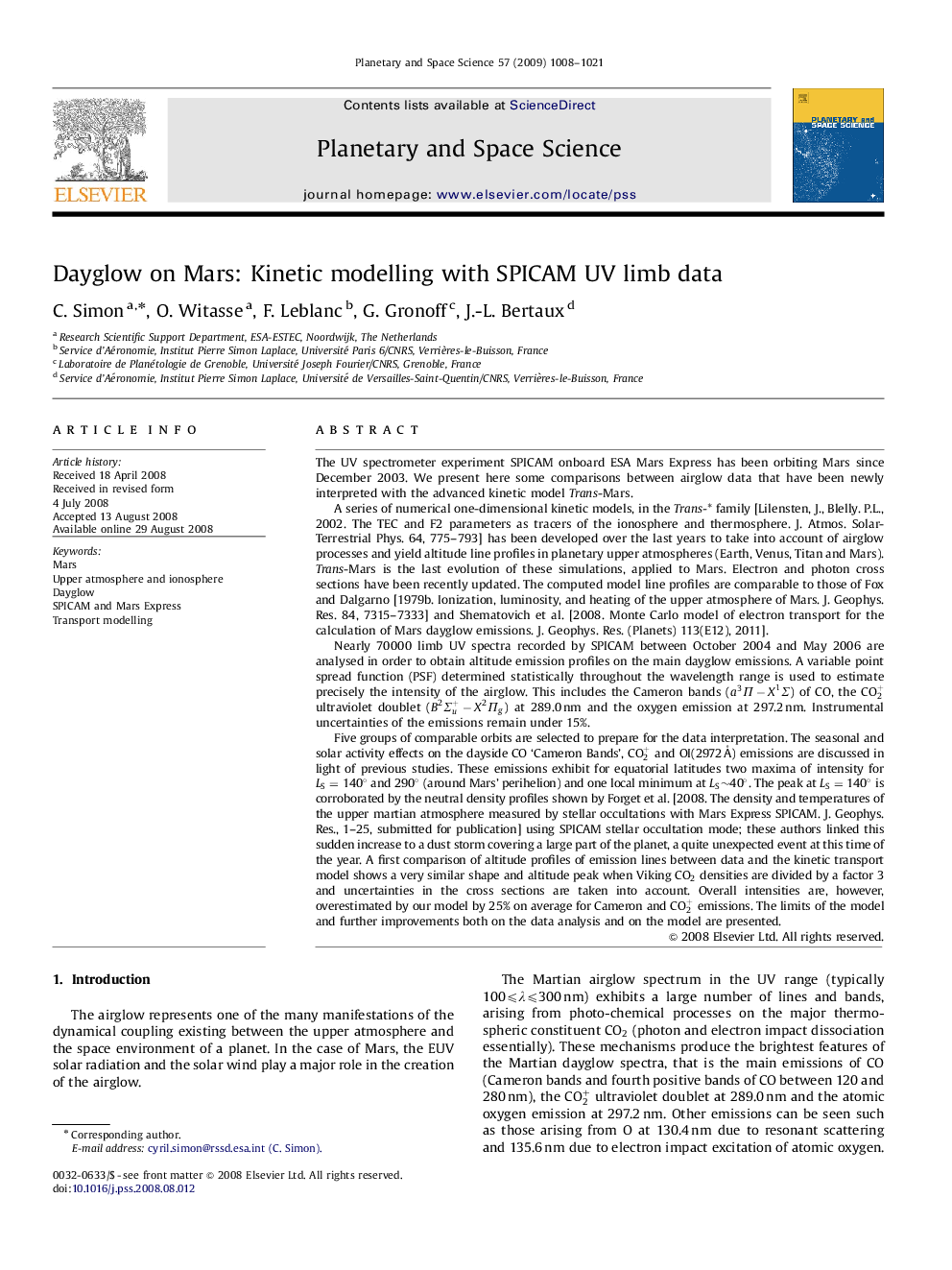| کد مقاله | کد نشریه | سال انتشار | مقاله انگلیسی | نسخه تمام متن |
|---|---|---|---|---|
| 1781821 | 1523970 | 2009 | 14 صفحه PDF | دانلود رایگان |

The UV spectrometer experiment SPICAM onboard ESA Mars Express has been orbiting Mars since December 2003. We present here some comparisons between airglow data that have been newly interpreted with the advanced kinetic model Trans-Mars.A series of numerical one-dimensional kinetic models, in the Trans-* family [Lilensten, J., Blelly. P.L., 2002. The TEC and F2 parameters as tracers of the ionosphere and thermosphere. J. Atmos. Solar-Terrestrial Phys. 64, 775–793] has been developed over the last years to take into account of airglow processes and yield altitude line profiles in planetary upper atmospheres (Earth, Venus, Titan and Mars). Trans-Mars is the last evolution of these simulations, applied to Mars. Electron and photon cross sections have been recently updated. The computed model line profiles are comparable to those of Fox and Dalgarno [1979b. Ionization, luminosity, and heating of the upper atmosphere of Mars. J. Geophys. Res. 84, 7315–7333] and Shematovich et al. [2008. Monte Carlo model of electron transport for the calculation of Mars dayglow emissions. J. Geophys. Res. (Planets) 113(E12), 2011].Nearly 70000 limb UV spectra recorded by SPICAM between October 2004 and May 2006 are analysed in order to obtain altitude emission profiles on the main dayglow emissions. A variable point spread function (PSF) determined statistically throughout the wavelength range is used to estimate precisely the intensity of the airglow. This includes the Cameron bands (a3Π-X1Σa3Π-X1Σ) of CO, the CO2+ ultraviolet doublet (B2Σu+-X2Πg) at 289.0 nm and the oxygen emission at 297.2 nm. Instrumental uncertainties of the emissions remain under 15%.Five groups of comparable orbits are selected to prepare for the data interpretation. The seasonal and solar activity effects on the dayside CO ‘Cameron Bands’, CO2+ and OI(2972 Å) emissions are discussed in light of previous studies. These emissions exhibit for equatorial latitudes two maxima of intensity for LS=140∘LS=140∘ and 290∘290∘ (around Mars’ perihelion) and one local minimum at LS∼40∘LS∼40∘. The peak at LS=140∘LS=140∘ is corroborated by the neutral density profiles shown by Forget et al. [2008. The density and temperatures of the upper martian atmosphere measured by stellar occultations with Mars Express SPICAM. J. Geophys. Res., 1–25, submitted for publication] using SPICAM stellar occultation mode; these authors linked this sudden increase to a dust storm covering a large part of the planet, a quite unexpected event at this time of the year. A first comparison of altitude profiles of emission lines between data and the kinetic transport model shows a very similar shape and altitude peak when Viking CO2CO2 densities are divided by a factor 3 and uncertainties in the cross sections are taken into account. Overall intensities are, however, overestimated by our model by 25% on average for Cameron and CO2+ emissions. The limits of the model and further improvements both on the data analysis and on the model are presented.
Journal: Planetary and Space Science - Volume 57, Issues 8–9, July 2009, Pages 1008–1021